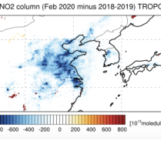
COVID-19 is currently affecting over 180 countries in the world and poses serious threats to public health as well as economic and social stability of many countries. Modeling and extrapolating in near real-time the evolution of COVID-19 epidemics is a scientific challenge, which requires a deep understanding of the factors undermining the dynamics of the epidemics. Despite the importance of having robust estimates of the time-asymptotic total number of infections, early estimates of COVID-19 show enormous fluctuations. It is difficult to project at the very start of an outbreak how it will end (and for multiple regions), especially when the data near the start of the outbreak are noisy due to the smaller sample size and of poor quality due to the overburdened testing facilities and lack of knowledge of a new virus. However, there are many similarities between the COVID-19 outbreak and the uncertainties of future climate projections.
The first common root is the non-linear nature of both phenomena. “Nonlinear” in epidemics means that a single patient can infect 3 more people who can infect 9 more and so on. This produces an exponential growth of infections: they do not double in double time (linear behavior) but they double every ~3 days. A similar picture is found when forecasting the evolution of the atmosphere. A small error made in the initial state of the atmosphere grows exponentially during the forecast until it reaches a saturation level. This evolution is deeply rooted in the nonlinearities of the evolution laws of the atmosphere.
Climate is also non-linear: if we double the CO2 content, effects on climate components are not necessarily twice as strong. A simple observation is that doubling CO2 concentration does not halve Arctic ice extent, but can lead to its complete decline. Multiple time and spatial scales increase the degree of nonlinearity in both climate and epidemics: in climate we need to model from cloud dynamics (few km and few hours) to the ocean and ice sheets dynamics (thousands of km and years). In epidemics, different time scales complicate the picture: infection, recovery and incubation periods are key parameters and the infection may spread differently for different populations, cities and countries. Another common point is the lack of resolved, good quality data: while in epidemics data relies on the abilities of knowing, every day, whether each individual of a population is infected or not, for climate studies, we need to sample physical and chemical parameters of atmosphere, oceans and other climate components on a fine spatial and temporal resolutions. Finally, both phenomena are greatly affected by human influence: their prediction can only be made under foreseen scenarios which crucially depends on economic and social policies.
All those factors lead to unavoidable uncertainties in the forecasts or projections that can be explored using simple or complex models. Models can provide important qualitative insights, not just at the early stages. For instance, when there is a basic (nonlinear) competition between effects, the analysis of models can be useful to formulate paradigms in terms of which to evaluate data in view of identifying the “state” where we are and where we may be heading autonomously or under certain policies. It does seem unfortunate that most of the time we do not seem to understand that uncertainty in predicting that non-linear functions can lead to a myriad of possible outcomes. They include mild and severe scenarios and we are used to getting prepared only for the average ones. Perhaps COVID-19 epidemics should teach us that, when dealing with complex systems, worst-case scenarios must be seriously retained. Have we learned the lesson?


